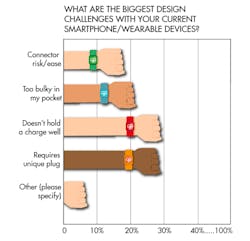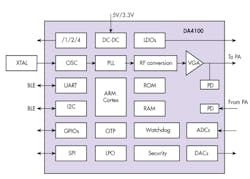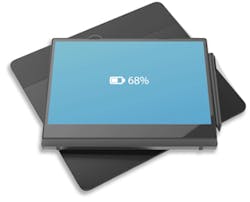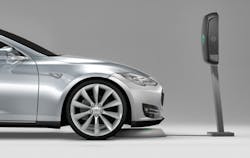This file type includes high resolution graphics and schematics when applicable.
Note: WiTriCity's Sanjay Gupta will be a speaker at the ID&E show this May. If you would like to learn more about what wireless power technology can offer, please register for the show and use the code IDEEARLY for a $400 discount off of the current early-bird rate. This offer expires Feb. 28.
The growth in awareness and adoption of wireless-charging technologies is quickly climbing. To keep moving forward, suppliers must understand the needs of the consumers in order to develop and launch better products. A survey on wireless power commissioned by the AirFuel Alliance and several of its members (e.g., WiTricity and Energous) looked into consumer perspectives on wireless-charging technology. Among the highlights:
- 71% want wireless charging in their next device, and they are willing to pay for it in public spaces.
- 72% say wireless-charging capabilities are important to them, and 62% of those individuals say speed of charge is also critical.
- 49% don’t even want to think about plugging in their smartphone or putting devices in a precise position to charge; they just want it to happen.
- 93% think wireless charging will become the new norm over the next three years.
After looking at the survey’s results, it is clear that customers want wireless charging throughout their connected lives—at home, at work, and even when traveling. Ideally, they’d like to get rid of all cords and the different charging ports needed for every device they own. Looking at Fig. 1, it’s clear that there are two main challenges to address: the unique plug and longer battery life.
The issue of longer battery life is related to battery anxiety, which is rather common. According to the survey, 45% of consumers report that they worry about losing the battery’s charge a few times a day. And almost all users of portable-power devices are concerned about their battery dying. This anxiety might be eliminated by making wireless fast-charging solutions easy to access in public spaces—especially since people are willing to pay for this capability.
Wireless charging also encourages a more reliable design, as charging ports allow dust and water to enter. In addition, their connector failures are often associated with design challenges (Fig. 1, again). By eliminating these ports, it saves consumers from having to carry different type of cables or plugs when they are on the go.
“We are surrounded by devices that must be juiced up periodically, be it plugging in our laptops at work or our phones when we go to sleep, requiring us to bring cords wherever we go,” says Sanjay Gupta, VP of product management for WiTricity. “Plugging in is not a natural human behavior, and consumers continue to demand freedom from wires and the ability to charge our electronics without putting thought to it.
“Just think—everything has become wireless except for the power cord itself,” continues Gupta. “Even autonomous devices, like drones, robots, or AGVs, are not truly autonomous until the cord is gone and humans are not required to charge them up. We are bringing our vision of a future where zero devices need to be tethered to a wall to a reality. Charging cords and power bricks will go the way of the rotary phone.”
Some of the challenges associated with wireless-charging technologies are related to the lack of a wireless-charging speed close to a wired-charging speed, constraints of spatial freedom, and power efficiency. At the moment, the more common wireless-charging technologies are:
- Resonance technology
- Inductive technology
- Radio-frequency-charging technology
Even though resonance technology isn’t new, its next generation is trying to give more spatial freedom to consumers. With this technology, a resonant copper coil can transfer energy to a second resonant copper coil oscillating at the same frequency. It also uses loosely coupled coils that eliminate the need for perfect alignment.
Companies like WiTricity are using resonant technology at higher frequencies (e.g., 6.8 MHz) to transfer power over distances that currently work well with metal housings, because at higher frequencies wavelengths are much smaller and can travel through certain materials. This enables wireless power transfer deeper into structures like desktops and coffee tables.
For inductive technology, coils must be perfectly aligned to make the connection to transfer power. It is commonly found on direct-contact applications that need to be closely coupled (e.g., the Apple Watch).
Radio-frequency-charging technology does not use coils, instead employing RF receivers and transmitters. The technology is often compared to Wi-Fi, and works by sending out RF waves from a charging station using multiple miniature antenna arrays. It claims to have the potential to transmit energy even up to distances of 15 ft.
Wireless-power technologies are still maturing. They still face challenges in terms of transfer distance and power efficiency. In addition, the industry has yet to agree on a universal standard.
Standard Needed
Even though wireless-power technology is gaining traction, the lack of standards interoperability is hampering its growth. Meanwhile, IC vendors and ecosystem providers are increasingly offering multi-mode options to support standards like AirFuel and WPC, with transmitters oscillating at different frequencies (e.g., 100-200 kHz, 5.8 GHz, and 6.8 MHz).
“As consumer awareness of wireless charging continues to increase, they are demanding an experience where they can power up their devices no matter where they are, without precise alignment on a charging pad or giving charging any thought,” says Gupta. “In order for that experience to exist, a universal standard must emerge so that all wireless-charging infrastructure (the devices, charging surfaces, value-added services, and their management) are interoperable.
“WiTricity has committed to creation of global standards to ensure interoperability and is working with leading members of the ecosystem to create global standards for wireless charging of all devices,” he adds. “Wireless-charging standardization efforts in the automotive side are fast maturing. The SAE announced a new standard for wirelessly charged electric vehicles this past week.”
Having looked at consumer views on wireless-charging technology, the types of technologies, and their challenges, let’s look at some of the products in the laptop, automotive, and peripherals and wearables markets already leveraging wireless charging. Examples include:
RF-Transmit IC
Dialog Semiconductor, in partnership with Energous Corp., offers the DA4100 WattUp Wireless Power Transmitter IC (Fig. 2). The IC, part of the Near Field WattUp transmitter system, is designed to charge a range of devices fitted with WattUp receivers. The chip has improved spatial and orientation freedom (WattUp technology can deliver power to multiple devices, in any orientation) and it operates directly from a 5- or 3.3-V power supply. Applications include the wireless charging of devices like fitness bands, hearing aids, Bluetooth headsets, smart pens, and remote controls.
Laptops
The new Dell Latitude 7285 laptop (Fig. 3) incorporates WiTricity’s Magnetic Resonance technology. As an AirFuel-certified product, it will be interoperable with the emerging magnetic-resonance-based wireless-charging ecosystem developed by WiTricity.
Automotive
Wireless charging for electric vehicles is still in its infancy, but most carmakers are looking into the adoption of this technology in future vehicles. Carmakers had already started to offer wireless phone-charging technology as standard equipment or a factory option, but now we are also hearing about commercial applications for Wireless Electric Vehicle Charging (WEVC) systems. For example, a company called Plugless offers wireless-charging solutions for electric vehicles like Tesla (Fig. 4) and Chevy Volt.
As wireless-charging technology keeps evolving, we are seeing next generations of inductive and magnetic-resonance designs, and now RF wireless-charging technology designs. With better infrastructure and a universal standard, wireless-power technology will be widely adopted not only by the mobile industry, but others such as the automotive, military, and medical device spaces, to name a few. In the future, we may see applications using gallium nitride (GaN) due to its efficiency at higher frequencies.
This file type includes high resolution graphics and schematics when applicable.
About the Author
Maria Guerra
Power/Analog Editor
Maria Guerra is the Power/Analog Editor for Electronic Design. She is an Electrical Engineer with an MSEE from NYU Tandon School of Engineering. She has a very solid engineering background and extensive experience with technical documentation and writing. Before joining Electronic Design, she was an Electrical Engineer for Kellogg, Brown & Root Ltd (London. U.K.). During her years in the Oil and Gas Industry she was involved in a range of projects for both offshore and onshore designs. Her technical and soft skills bring a practical, hands-on approach to the Electronic Design team.






